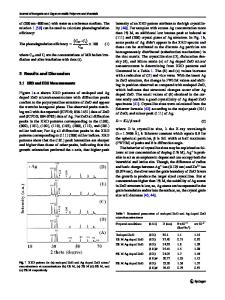Synthesis and luminescence properties of novel ZnO nanostructures: micro and nanospheres, polyhedral cages, tetra-pods,
- PDF / 1,760,176 Bytes
- 6 Pages / 612 x 792 pts (letter) Page_size
- 103 Downloads / 287 Views
0900-O06-18.1
Synthesis and luminescence properties of novel ZnO nanostructures: micro and nanospheres, polyhedral cages, tetra-pods, needles, tipped nanorods, nanowires and other “microphone–shaped” structures. Aurangzeb Khan1, Wojciech M. Jadwisienczak2 and Martin E Kordesch1 1
Department of Physics and Astronomy and CMSS Program, Ohio University, Athens, OH, 45701, USA. 2 School of Electrical Engineering and Computer Science, Ohio University, Athens OH 45701. ABSTRACT Novel ZnO nanostructures such as hollow nanospheres, nano-cages, nanoneedles, tetrapods, nanowires, aligned nanorods and nanotubes are synthesized via thermal evaporation of ZnO and graphite powder mixtures in reduced oxygen atmosphere in the presence of argon and nitrogen flows. The ZnO nanostructures, especially nanospheres, have a unique shape and are hollow inside with walls densely decorated with aligned nanowires. Photoluminescence of synthesized ZnO structures measured at 300 K exhibits a strong near band edge peak at ~380 nm and deep level green band centered at ~550 nm. Fabricated ZnO structures can be studied for various applications in optoelectronics and sensors. INTRODUCTION The syntheses of semiconducting nanostructures such as nanowires, nanorods and nanobelts have attracted much attention due to their morphology dependent properties and potential applications in nano-devices and optoelectronics [1-3]. The ZnO semiconductor is an important II-VI compound with wide band gap (3.37 eV at 300 K), good chemical stability, low-lasing threshold and high excitonic binding energy of 60 meV [4]. Also, ZnO in contrast to III-N materials is relatively easy to grow and bio-safe to handle. The synthesis of ZnO nanostructures have been widely studied with various growth techniques including physical and chemical vapor deposition, sputtering and laser ablation [5-9]. The combined thermal evaporation and vapor transport method is the one most frequently used due to the high yield, easy scalability and low cost [2,4]. ZnO materials synthesized in those ways have shown variety of morphologies affecting the optical, semiconducting, and piezoelectric properties [10, 11]. So far, the various applications of ZnO nanomaterials such as biosensors, UV detectors, nanocantilevers and nanoresonators are under way. Different shaped ZnO nanomaterials can be obtained by varying the deposition conditions in relatively ease way. However, precise control over ZnO nanomaterials synthesis remains a big challenge. Here, we report results of the synthesis and luminescence properties of various ZnO morphological structures grown in a tube furnace via the thermal evaporation and vapor transport method. In particular, novel highly symmetrical ZnO micro and nano spheres were fabricated in a two step grow process. These structures having unique shape and high volume-to-surface ratio might be attractive for biosensors or other applications. EXPERIMENTAL ZnO nanostructures were synthesized via combined thermal evaporation and vapor transport methods. A mixture of ZnO powder (99
Data Loading...











